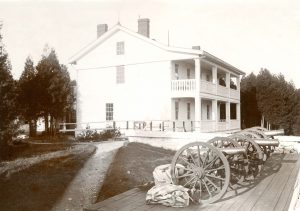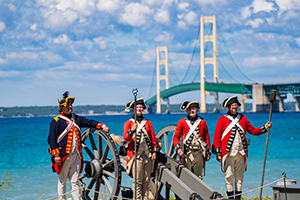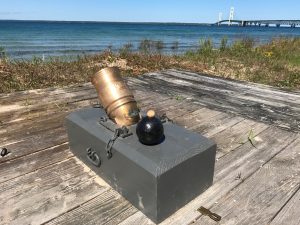
Artillery pieces always played a vital role at Fort Mackinac. Although their functions changed over time, these weapons were an important feature of the garrison for every soldier who served at the post from 1779 to 1895.
When British soldiers began constructing the fort in late 1779, their plans included multiple platforms for artillery. British troops relocated their artillery pieces from the old mainland fort at Michilimackinac. In 1780, Fort Mackinac’s artillery consisted of two mobile bronze 6-pound field pieces, two heavy iron 6-pound guns on stationary garrison carriages, four small bronze amuzetts, two wall guns, and a 4¼” bronze mortar. By the end of the British period in 1796, the artillery arsenal had grown to include two small iron howitzers and eight iron ½ -pound swivel guns. These weapons were scattered around the fort to provide point defense as well as long-range offensive fire. When the British turned over the fort to American troops in September 1796, they took all of their artillery pieces with them.
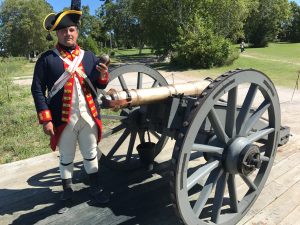
By the time the War of 1812 broke out, American defenses at Mackinac included two bronze 5½” howitzers, two bronze 6-pound garrison guns, one bronze 3-pound garrison gun, and two iron 9-pound garrison guns. These weapons were not enough to prevent the British from recapturing the fort on July 17, 1812. British troops discovered that some of the guns had been taken at the Revolutionary War battles of Saratoga and Yorktown in 1777 and 1781. The new British occupants bolstered the artillery arsenal, with nearly 25 pieces on hand by the time the war ended.
When American troops returned after the war ended in 1815, they had to mount new artillery pieces, as the British again removed their ordnance. In the years following the war the U.S. Army added and removed pieces depending on the perceived needs and threats at Mackinac. Colonel George Croghan, inspecting the post in 1842, sent most of the artillery pieces to Detroit. Since infantrymen garrisoned the fort at that time, Croghan believed that “an infantry garrison wants not a full battery.”
Nevertheless, artillery units did occasionally serve at Fort Mackinac. Battery L of the 4th Artillery Regiment arrived in 1852, perhaps armed with bronze 6- and 12-pound field guns. The men constructed a floating target and used the Straits of Mackinac as a practice range, but were forced to haul their guns up and down the hill from the fort every time they went to drill. Men from the 2nd Artillery Regiment served at Mackinac until the outbreak of the Civil War, when Captain Henry Pratt and Battery G were ordered to Washington D.C.
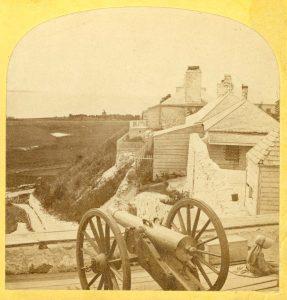
Following the Civil War, Fort Mackinac lost almost all military usefulness and in 1875 became the headquarters of the Mackinac National Park. The U.S. Army provided a small batch of obsolete artillery pieces for ceremonial purposes. These weapons included two bronze 6-pound guns, two bronze 12-pound guns, a 12-pound howitzer, and a massive 10” siege mortar. These weapons were fired with blanks to mark special occasions, such as the arrival of the first ship in the spring, George Washington’s birthday in February, the death of prominent generals and former presidents, and the 4th of July.
On a daily basis, members of the guard detachment fired one gun at reveille and retreat. By 1887, the cost-conscious War Department refused to authorize additional money for ceremonial firings. The guns of Fort Mackinac fell silent, prompting the St. Ignace News to report that “People passing near the fort in the evening, feel rather disappointed after they have humped themselves up into a ball and got ready for a shock to find that the cannon will not be fired any more. Nervous people will be glad; and people without clocks will be sorry to hear of this change.” Unfortunately for the “nervous people,” the War Department re-authorized ceremonial firings in late 1888.
When the last soldier left the fort, the War Department removed all of the artillery pieces. At the request of the Mackinac Island State Park Commission, in 1905 the federal government supplied other obsolete artillery pieces to arm the fort, by then an historic landmark and part of Mackinac Island State Park. The weapons remained on display until the early 1940s, when they were destroyed for a World War Two scrap drive. Today, two reproduction 6-pound cannons guard the gun platforms, and are used for demonstrations. The only historic artillery piece at Fort Mackinac is the “Perry cannon,” an iron 12-pound gun that served aboard the American fleet that attempted to recapture Mackinac Island during the War of 12. It is displayed in the Island Famous in these Regions exhibit.
